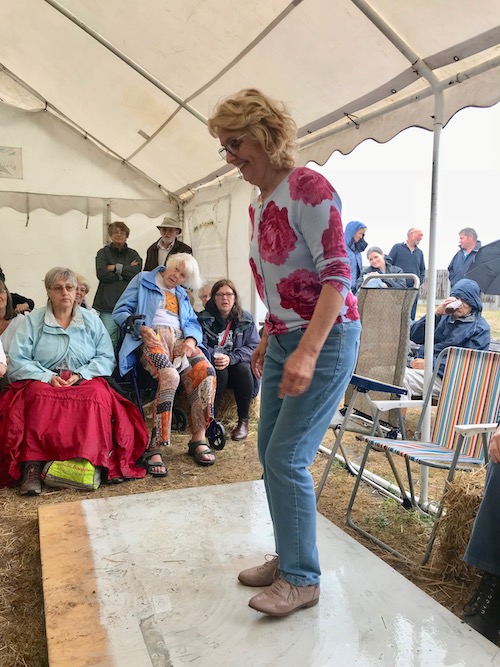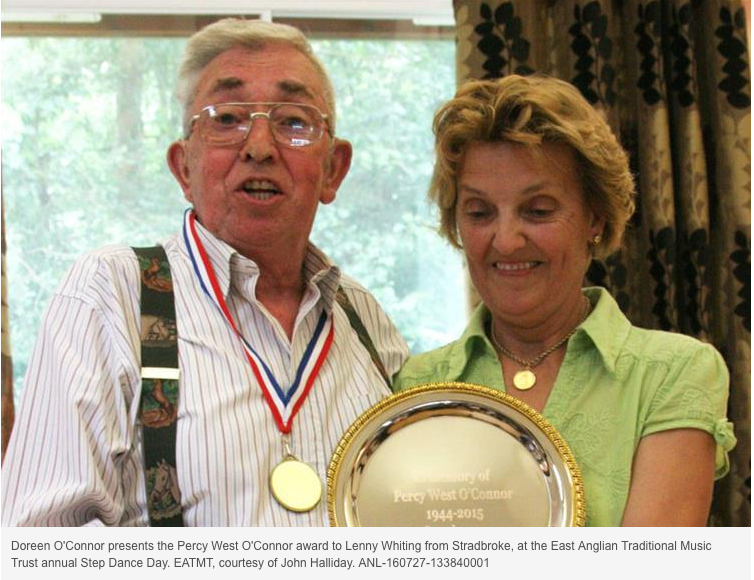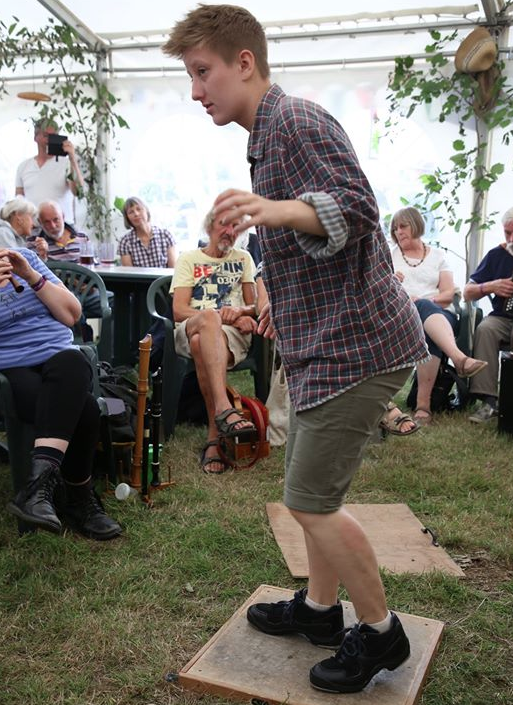- Written by Simon Haines Simon Haines
After going to this year's Stepdancing competition at the Blaxhall Ship, and witnessing first hand the brilliant dancing of Doreen West-O'Connor, I decided I'd interview Doreen to find out a bit more about what she does and how she does it. This is my interview with her. (It's obvious, I know, but my questions are in bold type and Doreen's answers are in italics.) Simon Haines
 Thanks for agreeing to talk to me Doreen. Can I start by asking you how you would describe the step dancing you do to someone who had never seen it?
Thanks for agreeing to talk to me Doreen. Can I start by asking you how you would describe the step dancing you do to someone who had never seen it?
Well, it’s a free-style dance. I could learn you a basic step and then at the end of the day, obviously when you’ve learnt that if you like to add something else in to it, then you can. It’s mainly about rhythm – you know. I always say it goes from the head to the feet. You know that’s the way I describe it to myself.
Who taught you?
I was self-taught.
But you must have seen someone else doing it, did you?
Yes, I’ve seen it hundreds and hundreds of times. My husband, Percy, inspired me more than anything - he was such a wonderful dancer. And he’d been dancing since he was eight. He had his own style – most steppers do have their own style.
So there’s a basic step which you would teach everybody and they add their own bits and pieces to make it theirs?
Yes, that’s how I would learn people to do it. Obviously it is about practising and watching other people. My granddad did it and I’ve got aunties that used to dance. But I never started to step dance until about 15 years ago and I did it by practising, observing, watching. But there’s not that many what we’d call East Anglian steppers about these days. They’d all have their individual steps, like Lenny Whiting. He’s got his own. And Lou Beal, she has too.
So what are the important things for you?
For myself I think it’s nice to get people to dance two feet the same. Some people only dance one leg; when I first started dance, I danced one leg and I thought “No, I mustn’t dance one leg – I’ve got to put two feet the same. So I’d do it first on one foot then change and do the other foot exactly the same.
Is that a thing you’ve got to get your head round?
Yes, you do, by practising. It can take years of practising. I used to practise with my hands. I know you might think “What’s that got to do with your feet?” but you can get the rhythm like that with your hands. You can see that and then try to do it with your feet.
How much practice do you do now?
None. I just get up and dance. I went to one the other night and danced for some Americans – about 50 Americans. We did a show with Rob Neal and them. And they just love it. In America, they call it different names - Appalachian or Foot-Stomping. And the steps are completely different. On Step-dancing day, there were differences. Some of them were more like Appalachian.
What about clog dancing? That’s got very particular steps hasn’t it?
Yes, they’ve got their set steps. I did try it once. I bought a pair of clogs and I tried to step in them, but there was no way because every time you tried to put your toe down, because the clog goes up, you’re tipping yourself forward and you can easily fall over- so I got rid of those.
 The shoes you wear are very light aren’t they?
The shoes you wear are very light aren’t they?
The shoes I wear are just a pair of ordinary hard-soled shoes, with Blakeys on or taps. I mean hundreds of years ago stepdancing was done in hobnailed boots and hard-soled leather shoes. Lenny Whiting only wears leather shoes; some dancers wear tap shoes and the reason we like to put Blakey’s or taps on our shoes is so the audience can hear the rhythm and the sound.
What about the surface you dance on. Some people use a board, don’t they?
Yes, traditionally it’s done on a board, or years ago they often used to do it on tin trays, especially in pubs– again to make sure you could hear the sound. And sometimes people did it on tables – I’ve actually done it on a table myself. Dusty Smith who used to be a dancer did it on tables. And if they’ve got a lovely tiled floor like they have at Blaxhall Ship, that sounds magnificent.
And how important is the music to you?
There are certain tunes that we all like to dance to. Stepping always used to be done with traditional music – the old squeezeboxes. But a lot of what we do now you could do to Country and Western, Swing Jive which is what I do – mainly to try and get people more interested in it. And when they see you do it, they think – “Oh that’s good”. So it doesn’t have to be the one particular type of music.
How about speed. I’ve noticed that people do it at very different speeds.
Yes – that all depends how fast your legs will go. I don’t like it too fast and there aren’t many who like it fast – because you can’t get your steps in. And if it’s too fast audiences can’t see what you’re doing. Though having said that, Percy was very fast and he could keep the rhythm. That’s why they used to call him Flying Feet Percy or Freddy Astaire and King of the Steppers. I’m pretty fast – but it makes your legs ache and then you don’t want to go as long.
And people dance for very different lengths of time, don’t they? Some people go through half the tune and others do 2 or 3 times through the tune.
Yeah – obviously it depends on your age. I always used to dance the whole tune through, but I don’t think I could do that now. It all depends on how I feel. I mean nine of ten steppers only dance for about a minute or a couple of minutes.
Could you tell me a bit more about Percy. What was he like as a dancer when you first met him? Did he teach you how to do it?
I was inspired by watching him. He used to say to me “Have a go.” And I’d say, “I don’t think I can do that.” “Yes, you can,” he said. So I said: “Show me your step” He’d get up and say “Now watch this” and he’d do a little bit and then he’d say: “It’s your turn now.” And I’d say “OK my turn, but what are you putting down first? Are you putting your toe down or the ball of your feet, or your heel and how many steps are you coming forward or going back for. He say “I tell you, it’s like this.” And then he’d just do it again. He was going so fast – he didn’t really know himself what he was doing.
And you said Percy had done it since the age of eight?
Yes, he was a little boy when started to dance.
And who taught him?
His dad did. He came from a very musical family, Percy did. All his family could either play an instrument or sing or dance. Percy could play the melodeon and the harmonica. He’d pick it up by ear. And he’d play his own tunes. I think it was Peter Kennedy interviewed his father years ago. And they had a tape-recording of where they sang and everything on it.
And where was that?
Percy used to live in Cambridgeshire and then they moved up this way and that’s when I met Percy.
And what about the step dancing competitions? Did there use to be competitions like the one last Sunday, or is that quite a new thing?
This competition goes back quite a few years – it was started by Steve Monks. It was up and running before we knew anything about it. The first one we went to was at the Eels Foot, at Eastbridge, near Leiston. And Blaxhall Ship used to have a competition quite a few years ago. That was the Sovereign Competition – and the prize was a genuine gold sovereign. There was either four or five of those and Percy won every one of them –I could only come second you see – I could never beat him.
Do you think the competitions have helped to keep the dancing going?
Yes, I do. It’s nice to have competitions cos everybody wants to win, but really it’s just nice if people enter. And they give you something to look forward to. To keep it going you’ve either got to have those competitions or you’ve got to have music nights that include the stepping and the jig dolls – and that is what I do.
I know you’re going to run some workshops, aren’t you? Could you tell me a bit about them?
I’m going to do one and see how it goes. I have done a couple before, but that’s years ago. So in my next workshops, I’ll learn people to do basic steps and then we’ll see what they can put together themselves. When people see me they say we like that bit can you teach us that? And as I tell them, once I’ve teached you my style I shan’t be very famous any more. After the workshops, hopefully they’ll just keep going and come to the music events, so when someone plays a melodeon in a pub or wherever, they’ll get up and have a dance.
Have you got people already?
I have got a few people, yes.
What sort of age are they?
I’ve got one little girl – she’s only 6. She was there at the competition. She’s only had about 5 goes, but she’s coming along and hopefully she’ll stick to it and the way she curtseys I taught her that: the curtsey and the kiss. I taught her to finish like that but for me the kiss is for Percy. Obviously it can be for everybody, but it’s for Percy more than anything.
Do you need a certain number of people to do the workshop?
No, as long as there’s enough to cover my costs. But obviously the more you get interested the more hopefully that will continue for many years. So if I only get five or six, that’s five or six more people. And, of course you’ve got to encourage them. And when I have my music nights – I encourage people from the audience to get up and have a go and sometimes it’s surprising who do get up and have a go.
Do you find that people who can do one type of dancing can adapt quite well to stepping? No, not necessarily. Do you remember Sue who was at the competition? Well she is a professional tap dancer and she does stage work and everything and when she first started to do step, she said “I can’t do this. I can’t change my steps to how you’re stepping.” I said, “But you can. There’s side kicks and back kicks in tap. Just cut them out and have a go like that.” And actually that did work in the end. So you can adapt, but it isn’t always easy and I get some people who do other types of dancing and say “Oh gosh no, we can’t do this” But obviously you’ve got to persevere with it. You’ve got to break your old habits. It’s the same when I try to do a new step. I have a go and I miss it and I think “Oh no”. But I’m quite happy with my stepping. Everybody loves my stepping.
No, not necessarily. Do you remember Sue who was at the competition? Well she is a professional tap dancer and she does stage work and everything and when she first started to do step, she said “I can’t do this. I can’t change my steps to how you’re stepping.” I said, “But you can. There’s side kicks and back kicks in tap. Just cut them out and have a go like that.” And actually that did work in the end. So you can adapt, but it isn’t always easy and I get some people who do other types of dancing and say “Oh gosh no, we can’t do this” But obviously you’ve got to persevere with it. You’ve got to break your old habits. It’s the same when I try to do a new step. I have a go and I miss it and I think “Oh no”. But I’m quite happy with my stepping. Everybody loves my stepping.
What sort of a future do you think step dancing’s got?
Well hopefully, many more years to come. I’ve got one son, but he’s not into nothing like that. He used to laugh at first when he saw his dad on the television and he said “What are you doing?” We taught Lou Beal to dance, and she’s got good rhythm.
And finally, tell us some of the high points for you over the last few years?
I’ve played with loads of celebrities, same with Percy. You know Ade Edmondson – we did a show with him and Katie and John Howson. Yeah. Percy danced and I did the jig dolls. And we did some work with the Wonderful Beast Company from Aldeburgh and other stage work. And we appeared on Bygones and Escape to the Country.
Thanks very much Doreen - that's fascinating. Good luck with the Workshop. Let's hope you manage to convert hundreds more people to stepdancing.
DOREEN'S STEP-DANCE DAY TAKES PLACE ON 6TH OCTOBER AT WILBY CORONATION VILLAGE HALL - SEE NOTICE

